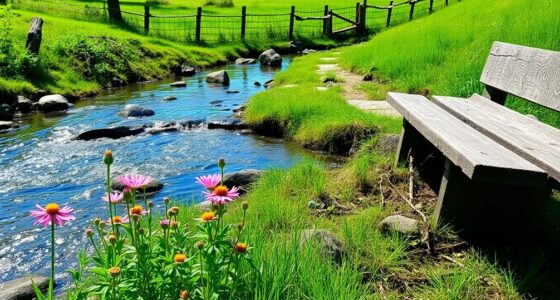Hot tub water appears blue due to a combination of light scattering, chemical balance, and mineral content. When light hits tiny particles in the water, it scatters, with shorter blue wavelengths projecting more vibrantly. The right pH level, between 7.2 and 7.8, along with balanced minerals like copper and magnesium, also plays a significant role in maintaining that color. Chlorine or bromine helps keep the water clear and free of algae, enhancing the hue even further. If you want to maintain that inviting glow, there's more to understand about proper maintenance and troubleshooting tips.
Key Takeaways
- Light scattering in hot tub water causes blue coloration, with shorter wavelengths scattering more effectively than longer wavelengths.
- Balanced pH levels between 7.2 and 7.8 are essential to maintain the blue hue and prevent color changes.
- Copper and magnesium minerals influence water color, with copper often creating a blue tint and magnesium deepening it.
- Clear water enhances the blue appearance; regular filtration and chemical monitoring are crucial for clarity and safety.
- Excessive copper from treatments or plumbing can lead to an unusual blue hue, necessitating regular testing and equipment maintenance.
Understanding Light Scattering
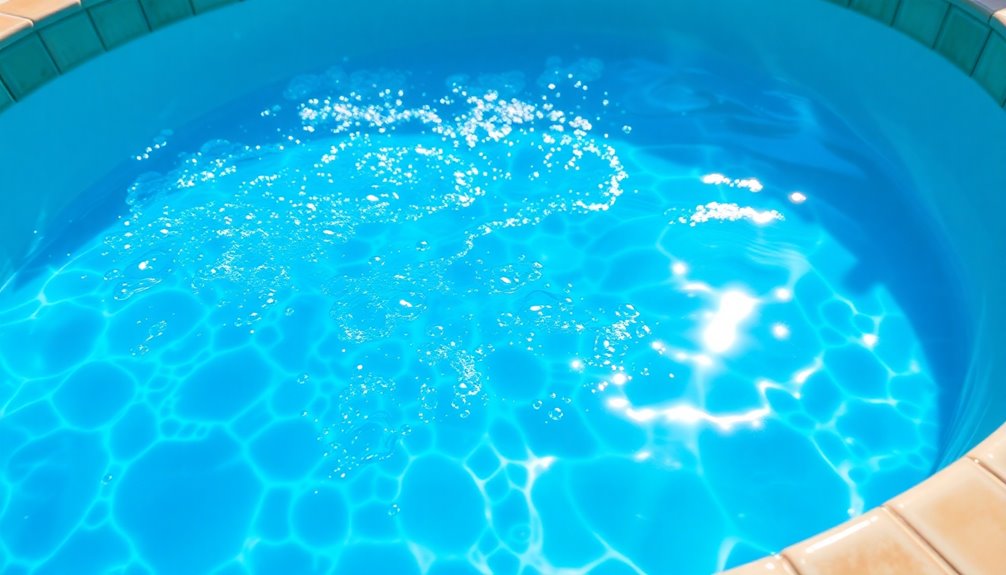
When light rays hit small particles in hot tub water, they scatter in different directions, creating an enchanting effect on the water's color. This light scattering phenomenon plays a significant role in how you perceive the water's hue.
Clear water appears blue primarily because shorter wavelengths, like blue, scatter more than longer wavelengths, such as red. If the water's clean and well-maintained, fewer impurities mean more effective light scattering, resulting in that vibrant blue you love.
However, when the water's cloudy, the presence of additional particles can alter this effect, making it harder to achieve that striking color.
Factors like sunlight angle and water depth also influence how light interacts with the particles, ultimately affecting your hot tub experience.
Role of Chemical Composition
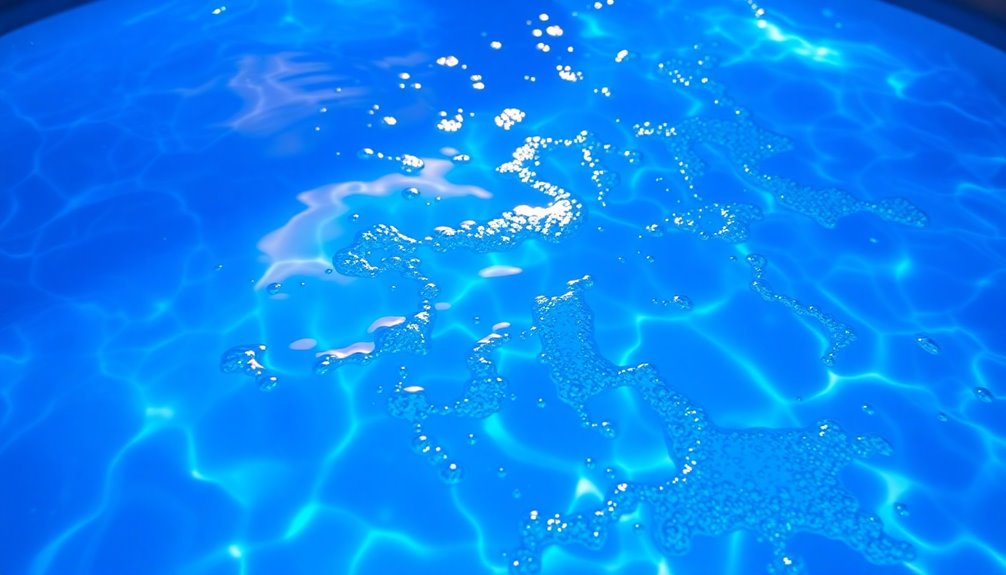
Chemical composition greatly impacts the blue color of your hot tub water, as various elements interact with light and each other.
To maintain that inviting blue hue, you should pay attention to several key factors:
- pH levels: Keep it balanced between 7.2 and 7.8 to prevent color changes.
- Copper ions: These can come from mineral treatments or copper plumbing, influencing the water's tint.
- Calcium Hardness: High levels of total dissolved solids, especially from calcium, can contribute to the blue appearance.
- Chlorine or bromine levels: Make sure they're adequate to avoid algae growth, which can alter the color.
Regularly monitoring and adjusting these elements will help you enjoy that stunning blue water every time you step in!
Impact of Mineral Presence
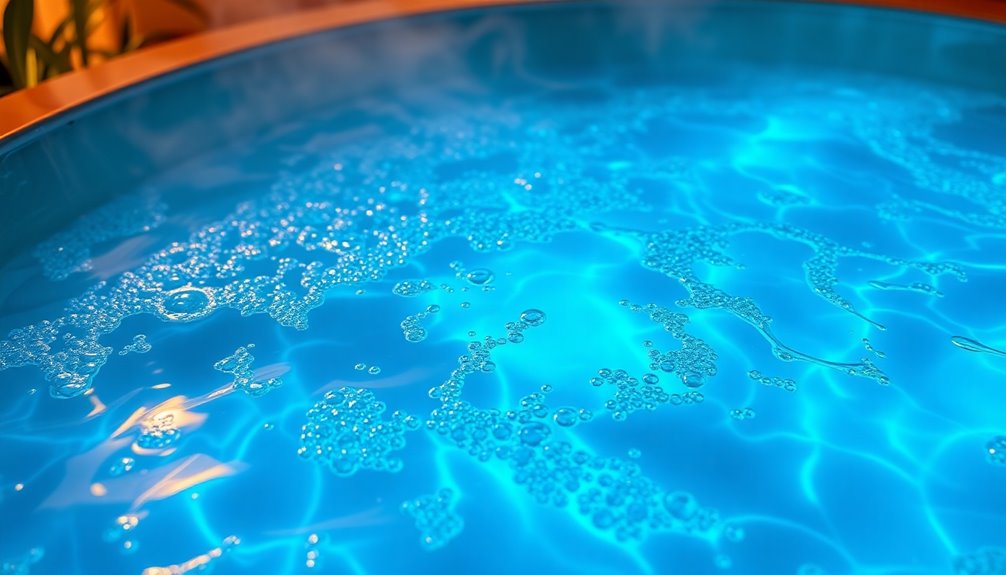
The minerals in your hot tub water, like copper and magnesium, play an essential role in its blue hue.
These minerals interact with the water chemistry, enhancing both color and clarity when balanced correctly.
Keeping an eye on mineral levels helps you maintain that inviting blue without unwanted side effects.
Mineral Types Affecting Color
Several mineral types can considerably impact the color of your hot tub water, particularly influencing its blue hue.
The right balance of minerals enhances the visual appeal and clarity of the water. Here are some key minerals that can affect the color:
- Copper: Corrosion from plumbing can introduce this mineral, creating a blue tint.
- Magnesium: High levels can deepen the blue shade, especially with proper pH.
- Calcium: Similar to magnesium, it can contribute to the overall color.
- Algaecides: Copper-based products may cause a blue hue, so monitor your chemical use!
Regular testing of mineral levels, pH, and alkalinity is essential to maintain that desirable blue appearance in your hot tub water.
Water Chemistry Interactions
Maintaining the right balance of minerals in your hot tub not only enhances its aesthetic appeal but also plays a significant role in water chemistry interactions.
The blue hue you see often comes from copper minerals reacting with sanitizer levels. If these levels are off, you might also notice algae growth, particularly blue-green algae, which indicates a need for chemical treatment. In addition to addressing sanitizer levels, regular maintenance and monitoring can help prevent algae buildup and maintain crystal-clear water. Interestingly, the vibrant blue-green hue has become a favorite among pool enthusiasts, as it mirrors the trendiest color of the year, adding a visually appealing element to your outdoor oasis. By staying on top of your pool care, you can enjoy a stunning, inviting space that reflects both cleanliness and contemporary style.
To prevent unwanted color changes, it's essential to balance pH between 7.2 and 7.8, as this stabilizes mineral presence. Additionally, high calcium hardness can cause cloudiness that appears blue under certain lighting.
Using chelating agents can help manage mineral levels, ensuring your hot tub water remains clear and inviting. Proper chemistry truly makes a difference!
Importance of Water Clarity
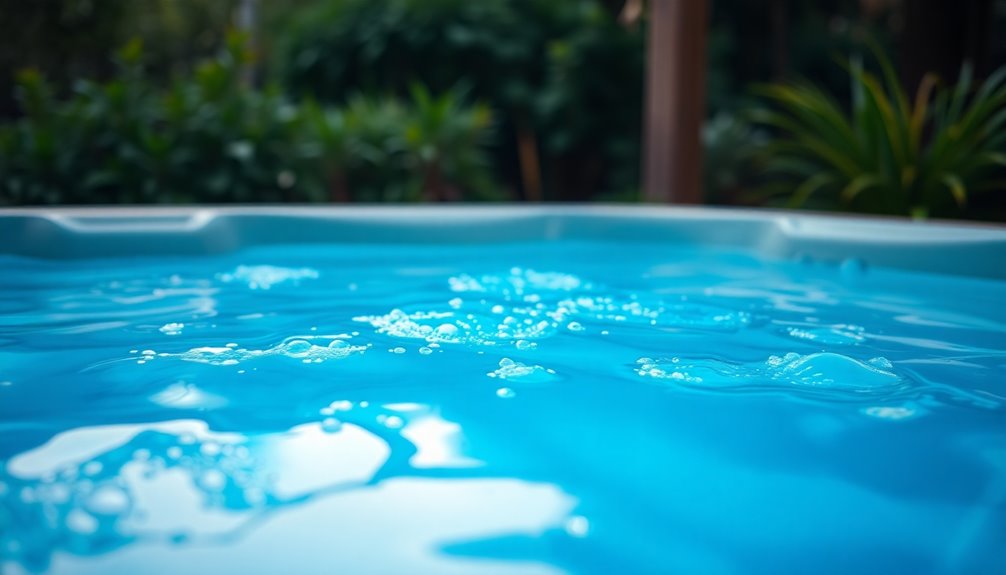
Why is water clarity so vital in a hot tub?
Clear water not only enhances your soaking experience but also guarantees your safety. Cloudy water can hide harmful bacteria and contaminants, posing health risks.
To keep your water clear and inviting, consider these important practices:
- Regularly monitor chemical levels like pH and sanitizer.
- Verify your filtration system is working effectively; clean filters weekly.
- Use shock treatments to tackle cloudiness and restore clarity.
- Drain and refill your hot tub every three months to prevent contaminants.
Maintaining Proper Chemical Balance
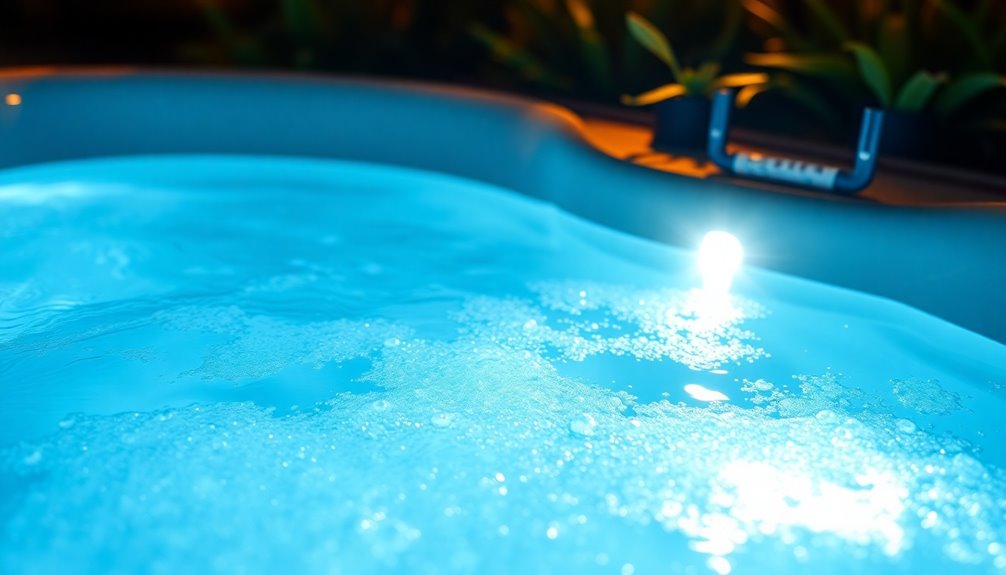
To enjoy a safe and pleasant hot tub experience, it's important to keep the chemical balance in check. Start by monitoring your pH levels, which should stay between 7.2 and 7.8. Deviations can cause discomfort and ineffective sanitization.
Additionally, maintain total alkalinity between 80 to 120 ppm to help stabilize pH levels and prevent fluctuations.
Don't forget calcium hardness, which should range from 200 to 400 ppm to avoid scaling and guarantee your water feels comfortable on the skin.
Regularly testing your water chemistry with test strips or kits is imperative for timely adjustments.
While you only need to adjust the chemicals once per fill, routine monitoring is critical due to changes from bather load and environmental factors.
Troubleshooting Color Issues

Even with a well-maintained chemical balance, you might still encounter color issues in your hot tub water.
If you notice an unusual blue hue, check these factors:
- Mineral Presence: Copper may come from chemical treatments or corroded metal parts.
- Chlorine/Bromine Levels: High levels can react with impurities, altering the color.
- Water Chemistry Testing: Regularly test pH and total alkalinity to guarantee balance.
- Equipment Maintenance: Clean filters and plumbing to prevent particle buildup.
Addressing these elements can help restore your spa water's clarity. Additionally, ensure that your hot tub's technical maintenance is regularly monitored to prevent further issues.
Consider using spa-specific clarifiers to maintain a vibrant, inviting hue.
Regular upkeep will keep your hot tub looking its best and guarantee a pleasant soaking experience.
Frequently Asked Questions
Why Did Hot Tub Water Turn Blue?
If your hot tub water turned blue, it's likely due to copper from corroded plumbing or high mineral content in your fill water.
Improper pH levels can also cause minerals to precipitate, changing the water's color.
Additionally, chemical reactions between sanitizers and organic materials can contribute to the hue.
Regularly test your water for copper levels to prevent staining, and consider using a chelating agent to manage dissolved metals effectively.
Why Is Tub Water Blue?
If you're wondering why your tub water's blue, it often comes down to a few factors.
Copper-based algaecides or minerals might be present, reflecting light in a way that creates that bluish hue. High calcium levels can also contribute, as they form deposits that enhance clarity.
Finally, certain bath products or environmental elements, like sunlight, can temporarily alter the water's color, making it look more vibrant.
Regular maintenance helps keep it looking great!
What Makes Hot Tub Water Crystal Clear?
Getting crystal clear hot tub water is like polishing a gemstone until it sparkles.
You'll want to maintain balanced chemical levels, keeping pH between 7.2 and 7.8 and alkalinity at 80 to 120 ppm.
Regularly clean and replace filters, and don't forget to use shock treatments to eliminate contaminants.
Monitoring water quality with testing kits lets you make timely adjustments, ensuring your hot tub stays inviting and clear.
Enjoy your rejuvenating soak!
What Turns Hot Tub Water Green?
Hot tub water turns green primarily due to algae growth, which thrives when sanitizer levels drop.
If you don't maintain proper sanitation and allow organic matter to accumulate, you'll encourage this unwanted bloom.
High phosphate levels from contaminants can also fuel algae.
Poor circulation and filtration create stagnant areas, making it easier for algae to flourish.
To fix it, you'll need to shock the water, adjust pH levels, and use algaecides.
Conclusion
To sum up, if you want your hot tub water to dazzle with that inviting blue hue, remember that it's all about the science behind light and chemistry. Keep an eye on the mineral content and maintain clarity for the best results. It's like a modern-day alchemy, turning regular water into a serene oasis. So, plunge in and enjoy the glow, knowing you've mastered the secrets of your own personal paradise!


